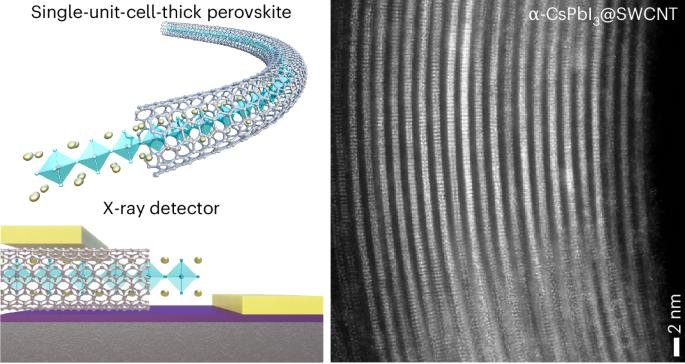Synthesis of single-unit-cell-thick perovskites by liquid-phase confined assembly for high-performance ultrastable X-ray detectors
IF 20
0 CHEMISTRY, MULTIDISCIPLINARY
引用次数: 0
Abstract
The instability of halide perovskites under working conditions or during complex postprocessing is challenging for practical applications. Here we developed a room-temperature, two-phase assembling strategy to synthesize single-unit-cell perovskite chains within single-walled carbon nanotubes (SWCNTs). This approach is efficient, scalable and tailorable, and can be used to assemble a range of single-chain perovskites. The single-unit-cell-chain perovskites show unconventional stoichiometries (such as [Cs4PbI5]+) due to dimensionality reduction and are balanced by negatively charged nanotubes. A direct X-ray detector constructed with high-entropy-Cs3MCl6@SWCNT exhibits outstanding performance, with a high sensitivity of $$1.22\times10^{4}\,\upmu{\mathrm{C}}\,{\mathrm{Gy}}_{\mathrm{air}}^{-1}\,{\mathrm{cm}}^{-2}$$ , a low dark current density of 0.2 nA cm−2, a negligible dark current drift of 8.5 × 10−7 nA cm−1 s−1 V−1 and a superior detection limit of 16.6 nGyair s−1. These surpass various common semiconductor and state-of-the-art perovskite detectors due to the ionic character of perovskite@SWCNT inducing a strong cation–π interaction, suppressing ion migration. The device is stable under harsh conditions, including continuous X-ray irradiation, high temperatures, exposure to ambient air for 91 days and immersion for 96 h in water. This low-cost synthetic methodology paves the way for the commercialization of potential perovskite X-ray detectors for medical and industrial applications. A two-phase assembly approach is developed to synthesize single-unit-cell-thick perovskite chains within single-walled carbon nanotubes. A direct X-ray detector constructed with the confined perovskite chains exhibits outstanding performance and ultrahigh stability under harsh conditions.

高性能超稳定x射线探测器用液相限制组装法制备单单元电池厚钙钛矿
卤化物钙钛矿在工作条件下或在复杂的后处理过程中的不稳定性对实际应用具有挑战性。在这里,我们开发了一种室温、两相组装策略来合成单壁碳纳米管(SWCNTs)内的单单元钙钛矿链。这种方法高效、可扩展、可定制,可用于组装一系列单链钙钛矿。单单元电池链钙钛矿由于维数降低而表现出非常规的化学计量(如[Cs4PbI5]+),并由带负电的纳米管平衡。用high-entropy-Cs3MCl6@SWCNT构建的直接x射线探测器具有优异的性能,灵敏度为$$1.22\times10^{4}\,\upmu{\mathrm{C}}\,{\mathrm{Gy}}_{\mathrm{air}}^{-1}\,{\mathrm{cm}}^{-2}$$,暗电流密度低至0.2 nA cm−2,暗电流漂移可忽略为8.5 × 10−7 nA cm−1 s−1 V−1,检测限为16.6 nGyair s−1。这些超越了各种常见的半导体和最先进的钙钛矿探测器,由于perovskite@SWCNT的离子特性,诱导强烈的阳离子-π相互作用,抑制离子迁移。该装置在恶劣条件下保持稳定,包括连续x射线照射、高温、暴露在环境空气中91天和在水中浸泡96小时。这种低成本的合成方法为医疗和工业应用的潜在钙钛矿x射线探测器的商业化铺平了道路。采用两相组装方法在单壁碳纳米管内合成单单元电池厚度的钙钛矿链。用受限钙钛矿链构建的直接x射线探测器在恶劣条件下表现出优异的性能和超高的稳定性。
本文章由计算机程序翻译,如有差异,请以英文原文为准。
求助全文
约1分钟内获得全文
求助全文

 求助内容:
求助内容: 应助结果提醒方式:
应助结果提醒方式:


